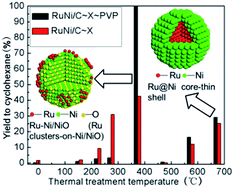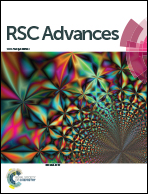Effect of the thermal treatment temperature of RuNi bimetallic nanocatalysts on their catalytic performance for benzene hydrogenation†
Abstract
The thermal treatment temperature of bimetallic nanocatalysts plays an important role in determining their catalytic performance. In this study, the synthesis of RuNi bimetallic nanoparticles (BNPs) supported on carbon black catalysts (denoted as RuNi BNSC) via hydrazine hydrate reduction and galvanic replacement reaction methods was reported. Then the effect of the annealing temperature in N2 (uncalcined, 160, 230, 280, 380, 480, 580 and 680 °C) of RuNi BNSC on its catalytic activity for the benzene hydrogenation reaction was investigated. It was found that RuNi BNSC calcined at 380 °C exhibited outstanding catalytic activity in the liquid phase hydrogenation of benzene to cyclohexane, which was about 3–4 times higher than that of RuNi BNSC calcined at 680 °C, while RuNi BNSC annealed at 480 °C had no activity for this reaction. The characterization results of the catalysts indicated that various thermal treatment temperatures in N2 affected the RuNi BNP size, chemical states of Ru and Ni, and RuNi bimetallic nanostructures and thus the catalytic properties.


 Please wait while we load your content...
Please wait while we load your content...